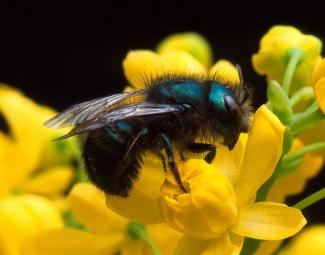
Image Credit: Jack Dykinga, U.S. Department of Agriculture
Iridescent Mason Bees (Megachilidae: Osmia, Hoplitis)
Mason bees have become a standard feature of nurseries throughout the Pacific Northwest, having been domesticated for pollination of almonds. They are excellent almond pollinators since all the pollen they collect is carried under their belly and can easily be dragged over the trees pistils and thus pollinated. The public has rapidly adopted them for backyard pollination; bundles of nesting tubes are a widespread phenomenon in gardens. Their iridescent blue, blue-green, green or violet reflections, together with their robust cylindrical body render them instantly recognizable; they are occasionally jet-black. Only recently have entomologists carefully studied them to reveal approximately 70 species inhabiting the PNW.
They are very intelligent bees, that encounter no difficulty in visiting pendant flowers (for instance, blueberries), closed flowers (like snapdragons, monkey flowers and the pea family), or beardtongue (Penstemon) flowers inside of which they often have to turn a somersault in order to harvest the pollen. Though nearly are probably potential generalist feeders, most exhibit heavy preference for members of the pea and aster families.
Nearly all Osmia females nest in pre-existing cavities, often burrows of long-horned beetles in wood or other bee species in the ground. One European species prefers empty snail shells for nesting! The female usually gathers mud to construct the walls of the individual cells; she may mix chewed up plant parts or plant resins into the mixture. I have observed a number of females jointly using a hole in the ground connected with a rodent burrow for their individual nests. I have also observed several species inhabiting talus on a mountain ridge; in this site, there was only the shallowest cover of windblown pumice (0-5mm only). Here, the females “swam” through the pumice dust to the bedrock and built (and re-used from year-to-year) their cells that were sometimes completely exposed to the elements.
The related genus Hoplitis has several metallic green and several jet-black species in the Northwest. They behave in most ways just like Osmia, but in addition they heavily frequent wild-heliotrope (Phacelia) for nectar. I have observed them nesting in the air-bubbles encased in lava rock. A specialist-feeder from England has successfully invaded the eastern United States along with its host plant, viper’s bugloss, Echium).


There are more than 100 species of Mason bees in the United States, nearly all are vividly metallic green to deep purple-violet. With 1 exception, they are very easy to identify to genus.


Occasional species of Osmia are entirely jet-black, here in the PNW these species specialize on either big sunflowers (Helianthus, Balsamorhiza) or thistles (Cirsium). On the right is a picture of Hoplitis fulgida, one of several species that is very easily confused with Osmia. Don’t worry about distinguishing them until you become an expert!